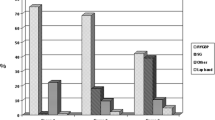Abstract
Background
The recent initiative for identifying centers of excellence in bariatric surgery calls for documentation of surgical outcomes. The SAGES Outcomes Initiative is a national database introduced in 1999 as a method for surgeons to accumulate and compare their data with summary national data. A bariatric-specific dataset was established later in 2001. The aim of this study was to compare the outcomes of bariatric surgery from the Society of American Gastrointestinal Endoscopic Surgeons’ (SAGES) bariatric database with data derived from a national administrative database of academic centers.
Methods
Between 2001 and 2004, 24 surgeons with 1,954 patients participated in the SAGES Bariatric Outcome Initiative, and 97 institutions with 42,847 patients participated in the University HealthSystem Consortium (UHC) database. Only 7 of the 24 surgeons participating in the SAGES Bariatric Outcome Initiative submitted more than 50 cases. The main outcome measures included demographics, comorbidities, type of bariatric procedure, operative time, length of hospital stay, short- and long-term complications, mortality, and weight loss.
Results
Both datasets were comparable for gender. Roux-en-Y gastric bypass had been performed for 88% of the patients in the SAGES database and 96% of the patients in the UHC database. Associated comorbidities were similar between the two groups except for a higher rate of hyperlipidemia for the patients in the SAGES database. The SAGES database contains more bariatric-specific information such as body mass index, operative time, blood loss, bariatric-specific complications, long-term complications, and weight loss data than the UHC database. According to the available data, no statistically significant differences exist between the two datasets in terms of perioperative complications and mortality.
Conclusions
The SAGES Bariatric Outcome Initiative provides valuable bariatric-specific data not currently available in an administrative database that may be useful for benchmarking purposes. However, this database is currently underutilized.





Similar content being viewed by others
References
Astor BC, Kaczmarek RG, Hefflin B, Daley WR (2000) Mortality after aortic valve replacement: results from a nationally representative database. Ann Thorac Surg 70: 1939–1945
Ferguson TB, Dziuban SW, Edwards FH, Eiken MC, Shroyer AL, Pairolero PC, Anderson RP, Grover FL (2000) The STS National Database: Current changes and challenges for the new millennium. Ann Thorac Surg 69: 680–691
Flum DR, Dellinger EP (2004) Impact of gastric bypass operation on survival: a population-based analysis. J Am Coll Surg 199: 543–551
Ghali WA, Rothwell DM, Quan H, Brant R, Tu JV (2000) A Canadian comparison of data sources for coronary artery bypass surgery outcome “report cards.” Am Heart J 140: 402–408
Khaitan L, Apelgren K, Hunter J, Traverso LW (2003) A report on the Society of American Gastrointestinal Endoscopic Surgeons (SAGES) outcomes initiative: what have we learned and what is its potential? Surg Endosc 17: 365–370
Kohn LT, Corrigan JM, Donaldson MS (2000) To err is human: building a safer health system. National Academy Press, Washington, DC
Livingston EH, Huerta S, Arthur D, Lee S, Shields S, Heber D (2002) Male gender is a predictor of morbidity and age a predictor of mortality for patients undergoing gastric bypass surgery. Ann Surg 236: 576–582
Nguyen NT, Root J, Zainabadi K, Sabio A, Chalifoux S, Stevens CM, Mavandadi S, Longoria M, Wilson SE (2005) Accelerated growth of bariatric surgery with the introduction of minimally invasive surgery. Arch Surg [In Press].
Nguyen NT, Paya M, Stevens CM, Mavandadi S, Zainabadi K, Wilson SE (2004) The relationship between hospital volume and outcome in bariatric surgery at academic medical centers. Ann Surg 240: 586–593
Podnos YD, Jimenez JC, Wilson SE, Stevens CM, Nguyen NT (2003) Complications of laparoscopic gastric bypass: a review of 3464 cases. Arch Surg 138: 957–961
Author information
Authors and Affiliations
Corresponding author
Rights and permissions
About this article
Cite this article
Nguyen, N.T., Morton, J.M., Wolfe, B.M. et al. The SAGES Bariatric Surgery Outcome Initiative. Surg Endosc 19, 1429–1438 (2005). https://doi.org/10.1007/s00464-005-0301-8
Received:
Accepted:
Published:
Issue Date:
DOI: https://doi.org/10.1007/s00464-005-0301-8




